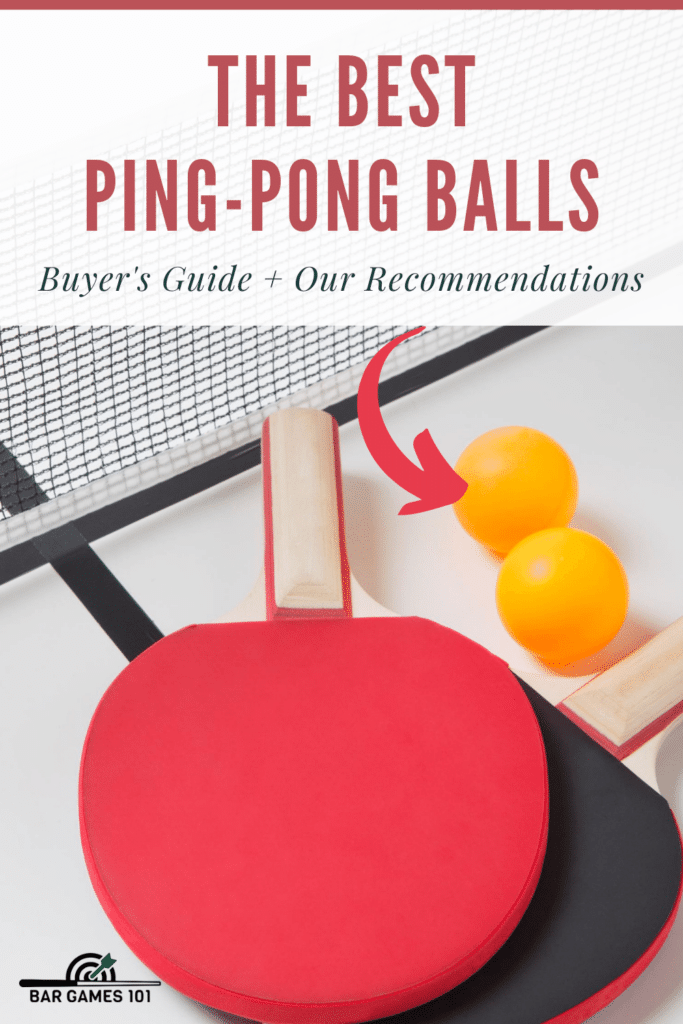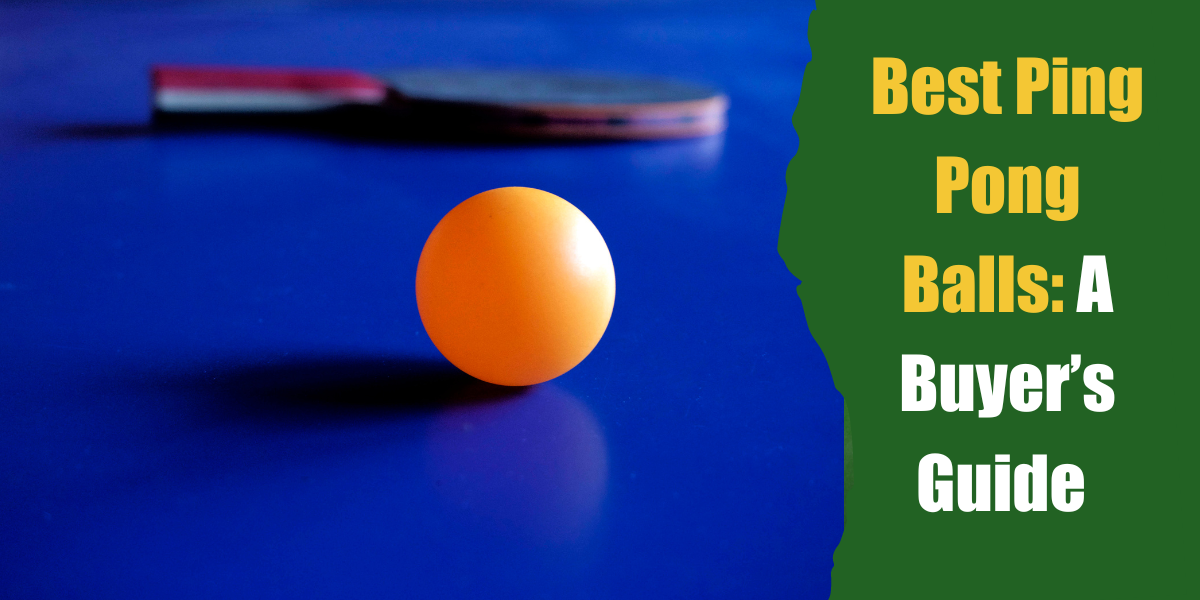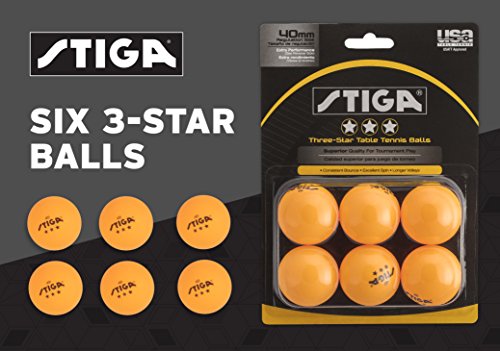To the untrained eye, choosing the best ping pong balls may not seem like a big deal.
As both the least expensive and most frequently replaced part of your ping-pong paraphernalia, it’s tempting to pick up the first pick you come across without diving into the kind of research you’d normally do when buying a new table or even just selecting a good quality paddle.
Talk to anyone who takes their table games seriously, however, and they’ll be quick to tell you what a literal game-changer the right set of balls can be.
Choose well, and a good quality set from a reputable brand can add a whole new level of enjoyment. Choose poorly, however, and a poor quality product can put a bigger dampener on your evening than prematurely running out of beer.
With that in mind, we’ve given 2023’s top brands a run for their money and put together this comprehensive guide to the best ping pong balls you can buy this year.
Best Ping Pong Balls 2023 – Our Top Picks
| Product | Material | Rating | Type | |
| 1. | Nittaku Premium 40+ | Non-celluloid plastic | 3-star | Competition-grade |
| 2. | Portzon 40+ Balls | ABS | 3-star | Competition-grade |
| 3. | STIGA 40+ | Polystyrene | 3-Star | Training-grade |
| 4. | Butterfly A40+ 3 Star | ABS | 3-Star | Competition Grade |
| 5. | Joola Magic 40+ | ABS | 2-Star | Training-grade |
1. Nittaku Premium 40+
Nittaku didn’t become one of the world’s best-selling ping pong ball manufacturers by accident. Their superior quality and terrific performance has helped make them a favorite of professional players for decades.
Since as far back as the 1920s, they’ve been the preferred supplier of competition-grade balls for three Olympic Games, seven European Championships and 13 World Table Tennis Championships, not to mention countless national competitions around the world.
Testing Nittaku’s products for yourself, it soon becomes apparent why they’re so universally popular. Their ITTF-approved Premium 40+ brand is the most consistently well-performing ball on the market, not to mention the most durable.
Their perfectly round-design also makes them significantly faster than many other three-star brands we’ve seen, with medium spin, no-wobbling and excellent bounce.
On the downside, Nittaku Premium 40+s are one of the most expensive balls on the market, but the outstanding quality and performance make them a great purchase if you’re serious about improving your game.
2. Portzon 40+ Balls
To be honest, it’s hard to decide what we like best about Portzon 40+ Table Tennis Balls, the affordable price or the awesome performance.
Available in a whopping big box of 50 highly-durable three-star balls, they’re guaranteed to last you a long while yet are nowhere near as expensive as our top-ranked Nittaku Premium 40+ when compared like-for-like.
Then there’s the way they perform.
It’s a rare feat for a ping pong ball to be super fast while still offering exceptional control, yet Portzon 40+s do it with ease.
Oh, and did we mention that they do all this while being remarkably strong at the same time? Portzon boasts that their premium-grade balls can take over a thousand hits without cracking, ensuring the kind of durability that makes them the perfect choice if your games tend to get pretty intense.
Portzon also boast that their 40+s are manufactured to competition standard, which is why we’ve ranked them as such on this guide, but given how cost-effective they are, they’d make a great choice for training balls.
3. STIGA 40+
Approved by USA Table Tennis, STIGA’s orange-colored table tennis balls are an attractive option for anyone who wants the quality of a three-star ball without paying over-the-top pricing.
Though they may not offer the same kind of bounce quality that you’d get with our higher-ranked picks, you’re still getting a quality product that makes them a good choice for serious table tennis training as well as bars and game centers committed to delivering a quality game experience.
Offering above-average spin control, decent durability and minimal in-flight wobbling, STIGA 40+ ping pong balls are definitely an option worth your consideration.
4. Butterfly A40+ 3 Star
Nittaku may hold the record for the most frequently featured name at international table tennis competitions, but the Butterfly brand certainly gives them a run for their money.
Taking pride of place as the official tournament ball for both the 2018 and 2019 editions of the World Table Tennis Championship, Butterfly’s A40+, 3-star balls guarantee above-average performance and ITTF-standard design.
Like our second-placed pick, the Portzon 40+s, Butterfly’s A40 balls manage to be lively and lightweight while still offering impressive spin control and minimal wobbling.
That isn’t the only area where Butterfly impresses.
Despite being one of the lightest and thinnest options we’ve featured, these competition-grade balls more than hold their own in durability tests, being able to withstand hundreds of heavy hits without showing any signs of damage.
If you’re on the hunt for a quality ball built with ABS material, this should definitely be on your radar.
5. Joola Magic 40+
There’s a good reason why we’ve focused exclusively on three-star choices up until now:
They are the literal definition of the best ping pong balls money can buy.
Still, let’s be honest, most of them cost a lot more money than you’re prepared to spend on something you’re only going to use for the occasional fun game with your friends.
So we’d be doing you a disservice if we didn’t feature at least one low-cost option in this guide, especially when the option we’ve picked -the Joola 2-star 40+ training balls- are of such impressive quality.
Out-performing many of the two-star varieties currently on the market, Joola’s ABS balls are medium-fast with a level of spin that is typical of two-star varieties.
What we like best, of course, is the cost. The most budget-friendly brand we’ve featured today, Joola products are always a solid option if you’re looking to spend as little as possible yet still have a quality gaming experience.
On the downside, these aren’t ITTF approved and you may find that some balls in your pack don’t have the same perfectly round shape that you get with other, higher-ranked products.
That aside, this is a good value-for-money product for casual use.
Ping Pong Ball Buyer’s Guide – What Makes a Good Quality Ball?
Spend any amount of time searching for a set of good quality table tennis balls and you’ll soon find yourself inundated with options. So how do you know that the brand you’ve got your eye on representing good value for money?
Below, we’ll explore the key factors that go into making a high-quality product, all of which we used to determine our own top picks.
ITTF-Approved Ping Pong Balls
The International Table Tennis Federation is the global governing body overseeing national table tennis associations around the world. As well as setting the rules and regulations for the sport itself, they also have strict standards about which balls can be used in competitions.
For example, they state that for a table tennis ball to be ITTF-approved, it must be 40mm in diameter, weigh between 2.67 and 2.77 grams and be either white or orange in color with a shineless matt finish.
Elsewhere, the Federation also insists that when balls are dropped onto a steel block from a height of 305 millimeters they bounce back to between 240-260 millimeters.
If you’re doing nothing more than enjoying a few light-hearted games with your buddies on a Friday night, then buying ITTF-approved balls may not be top of your priority list. Even still, it’s worth if you do buy a brand with their stamp of approval, it’s guaranteed to be a good quality product.
Table Tennis Ball Star Ratings
You’ll notice in our guide that each set of ping pong balls has a star rating between one and three. There are three important things you need to know about these ratings:
1: We didn’t come up with them ourselves. Assigning a star rating to balls is a common practice within the sport of table tennis.
2: The ratings are representative of the balls’ quality. Three stars mean the ball is highly durable and of high quality, while one-star tends to mean that it is a cheap product of limited quality.
Of course, you may also find some balls that have no star ratings at all, though these tend to be children’s toys or those best used only for games like beer pong.
3: Even though it’s common to give ping pong balls a star rating, there’s an industry-standard system for applying these ratings and it’s up to each manufacturer to decide how many stars they give to each particular product.
For example, one manufacturer might give a three-star rating to one type of ball to demonstrate that it is of better quality than their own two-star products. However, a three-star ball from one brand may only be as good as a two-star one from another.
If that sounds confusing, don’t worry. All you need to know is that the higher the rating, the better, with the ITTF usually only giving their stamp of approval to most manufacturer’s three-star balls.
What are the Different Types of Ping-Pong Balls?
A ball’s star rating is generally a good indication of what it’s best used for, with most varieties falling into one of three categories.
Recreational Ping-Pong Balls
These are your cheap, one-star balls that tend to be made from the thinnest materials and don’t offer the same kind of powerful bounce that you’d get with a better quality brand.
On the plus side, they are incredibly inexpensive, so they do make a great option for casual, lighthearted table tennis games with friends or to keep stocked up next to the beer pong table in your bar.
Training Balls
These two-star balls are the ones typically used in table tennis clubs when players are training for a competition. They offer a much better quality than you get with recreational balls, but tend to be lighter and not quite as good as top-brand competition balls.
Table Tennis Competition Balls
If you take your table tennis seriously, or if your bar is part of a local ping pong league, the competition-grade, three-star balls are well worth the investment.
As the name implies, these are the top-standard variety used in high-profile competitions and professional-level events.
While that naturally makes them the most expensive option, the superior quality typically justifies the expense.
You can easily tell competition-grade table tennis balls apart from inferior products as they’ll be ITTF-approved with “40+” stamped on the surface.
Does Color Matter?
Professional-grade, three-star table tennis balls come in either white or orange. This is to make them easier to track while a game is in progress, but there is honestly no difference between the two.
It’s also possible to buy ping pong balls in just about every color under the sun, and if you’re using them simply for bar games or home entertainment then it really doesn’t matter what color they are.
What Makes the Best Ping Pong Ball Material?
There once was a time when celluloid was the go-to material for all ping pong ball manufacturers. These days, while it is still used in the cheaper, one-star varieties, celluloid has been largely replaced by two other materials, Polystyrene and ABS.
Polystyrene is an affordable, environmentally-friendly material that is found in many two and three-star rated balls. Many of the mid-range brands that you find today will likely use this material.
Another option is ABS, or Acrylonitrile Butadiene Styrene to give it its full title.
Although still a relatively new addition to the ping pong market, ABS balls are being produced by an increasing number of manufacturers and are becoming an ever-more present sight at professional-level competitions.
To sum up, if you’re looking for serious quality, polystyrene or ABS are the way to go. If low-cost matters more to you than high quality, celluloid is the way to go.
What Does 40+ Mean on Ping Pong Balls?
40+ refers to the size of the ball.
At the turn of the millenium, the ITTF updated their guidelines for making table tennis balls, insisting that an upgrade from the old 38mm balls to those measuring 40mm would slow the game down to be better presented on television.
Then, in 2014, it made balls made from materials like ABS legal for use in competitions. When they did so, they also updated the size parameters that competition-grade balls had to fall into. As such, the new balls tended to be slightly bigger than 40mm, hence the 40+ label.
ABS 40+ balls tend to be among the best available as they offer better spin control and greater durability than the smaller, celluloid brands.
Testing Before You Buy
These days, you’re more likely to buy your ping pong balls online and when it comes to saving money that’s no doubt a smart idea. Still, there’s a lot to be said for actually paying a visit to your local sporting goods store to check out the brands you’re thinking of buying.
For one thing, there’s a better chance of speaking to someone who knows what they’re talking about and can advise you on the best ping pong balls for your needs.
For another, you can actually test out the balls you’re interested in and see if they really are as good as that online sales pitch said they were.
To test them out, first, hold a ball firmly between your thumb and forefinger.
If it holds steady and doesn’t indent at all, that’s a sign of a seriously good quality ball. If you find that your finger presses into the surface but that the ball resumes its natural shape, that means you’re looking at a one or two-star quality ball that may still be OK for general use. If that ball becomes permanently misshapen, however, that likely means it won’t be good for much more than giving your kids something to play with.
You can also try the spin test. Place the ball on a flat surface and spin it. If it spins well and doesn’t wobble, it’s a much better quality ball than one that wobbles all over the place or doesn’t spin at all.
Final Thought: Choosing Between Cost and Quality

By now, we’ve given you everything you could possibly need to know to help you make an informed decision when buying new ping pong balls. Yet if you’ve reached this point and you still can’t decide which one of our top five brands to spend your money on, here’s a question that we hope will nudge you in the right direction:
What matters more to you – high quality or low cost?
If quality and performance is what’s most important, then you definitely can’t go wrong with our number-one ranked Nittaku Premium 40+s. The ball of choice for scores of leading international competitions (including the Olympic Games no less), they really are a cut above just about anything else on the market.
However, that quality does come at a cost, and if you do decide to buy them, be prepared for the high price tag.
If, on the other hand, what concerns you most is getting the best quality for the least amount of money, then you might be better off sticking with low-cost, two-star brands like our fifth-placed pick, the Joola Magic 40+s. Though not on par with their three-star counterparts, these do make a great choice if you’re just looking to stock up on some cheap ping pong balls for recreational use.







